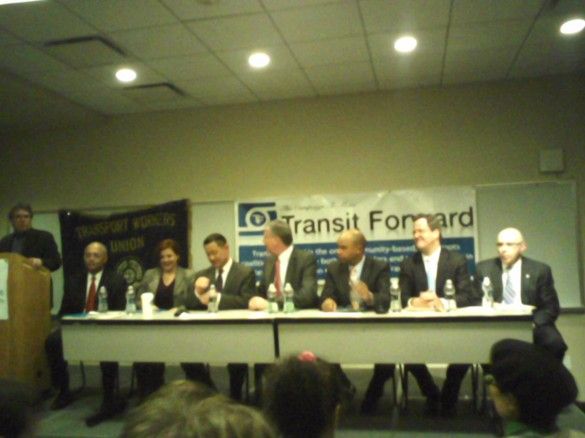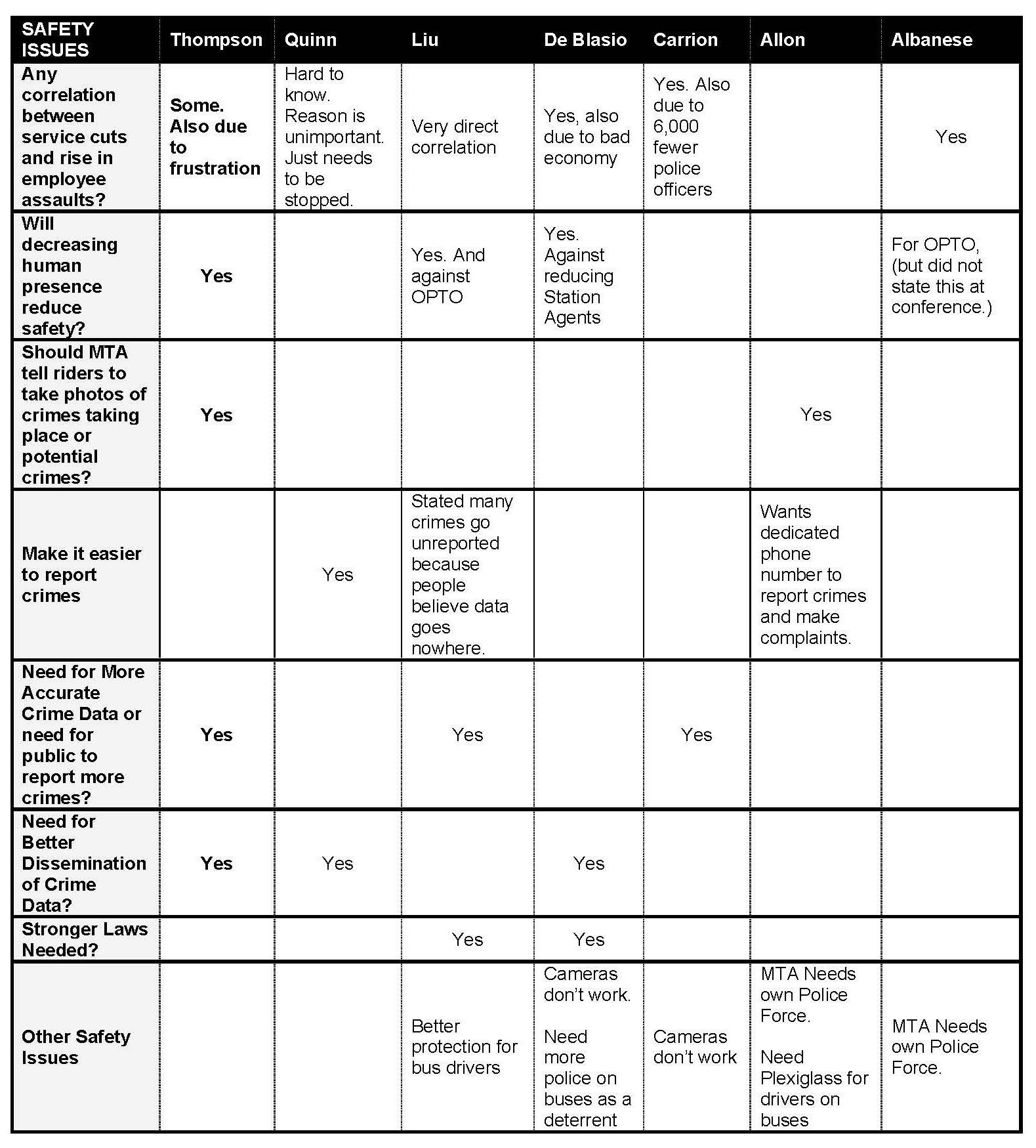Mayoral Candidates Square Off On The Future Of Transportation – Part 3 Of 3

THE COMMUTE: In Part 1 of this series, I reported on the candidates’ positions regarding major transit issues. In Part 2, I addressed financial issues. Now we will discuss safety, and sum up.
The first half of the conference addressed safety, both for transit employees as well as passengers. It is an issue that has been in the headlines recently and is a major concern for both parties.
The union implied that the number of passengers falling onto the tracks is increasing, stating that four people fell just during the past week. They did not mention their heavily criticized plan to slow down trains to make the subways safer. This issue was also not addressed further by the panelists.
Union officials mentioned that in 2010, there were the most service cuts ever, and also the most incidents of employee assaults. The question asked was: Is there a correlation between the 2010 service cuts and the rise in incidents of employee assaults?
Tom Allon called for the addition of auxiliary police in the subways.
Sal Albanese asked for more effective ways for riders to report violence. He further stated that the Transit Bureau is considered the Siberia of the NYPD, suffering from a lack of experienced personnel.
Adolpho Carrion stated that daily crime data from station managers is not forwarded to the NYPD on a timely basis. He also said that the public is not given clear instructions what to do in case of a crime. He is a big believer in the “broken window theory,” which means you should address the small problems to prevent bigger ones from occurring. He said that this cannot be done when you cut the police force by 6,000 future officers as the current mayor has done.
Bill De Blasio criticized the MTA for not recognizing the extent of the crime problem. He further attacked the MTA stating that it is difficult for employees to report a crime since MTA policy does not permit them to contact the police directly (They must first contact the NYCT Command Center), and called the MTA attitude regarding employee attacks “cavalier.”
Christine Quinn mentioned that funding was granted to develop a mobile application to track/report crimes. She also supports increasing police resources.
The safety scorecard is on the right:

Commentary
Those who advocate that the MTA direct passengers to take pictures of criminals do not realize such an act could endanger the safety of the photographer and expose the MTA to lawsuits. Perhaps that is why the MTA has kept silent on that issue. Also, those advocating for the MTA to have its own police force need to recognize that it already does. However, they only patrol on the rail lines. If what they are proposing is that the Transit Bureau be split off from the NYPD, they need to make that clear. Also, the MTA has already begun a program to install Plexiglas to better protect bus drivers. This is not a new idea, as claimed. I could not follow Quinn’s logic regarding solving a problem without needing to know the reason that caused the problem.
Conclusion
Some interesting ideas were raised at this conference, put forth mainly by Liu, Albanese, Thompson, de Blasio and Allon, although Allon’s transit knowledge seemed to be limited. Quinn and Carrion were the least impressive, because they provided the least amount of specifics in their responses. I thought Quinn showed the poorest knowledge of transportation issues and was pandering to the union and to Transportation Alternatives in her responses.
Quinn seemed to believe that if we operate new ferry routes our mass transit problems would all be solved. While some new ferry routes may be beneficial, that is far from a solution. However, as City Council president, helping to create ferry services and advocating for the #7 line extension is all she could boast about.
If she really understood transit, she would know what a Rockaway resident recently e-mailed me: the ferry is only half full because it is not publicized and there are no bus routes available to access it. That is unlike New York Waterways, which provides its own buses to access its ferries. Here is a portion of the e-mail I received:
I recommend everyone take this Ferry and keep it going. It’s so much better than any other mode of transit. It’s fast, safe, beautiful views, comfortable, smooth, clean, friendly, it has a snack and beverage bar and its affordable. The best way to travel to Rockaway and downtown Manhattan. We have to keep it. I’m telling everyone to take this amazing trip. We cannot lose this transit option. I will take this ride anytime I’m going to the city. It’s such a pleasure…
Ferry routes started by the city usually are discontinued after a few years due to lack of ridership or because the funding runs out. Please tell me why the city could not use a testimonial like this in an ad campaign and provide bus access to the ferry or petition the MTA to do provide it? If Quinn or the city really wanted to make ferries work, they would do what it takes to make them a success.
Implementing programs without necessary follow-up does not make you a good mayor. If you are going to take credit for something, you should at least do the job correctly. If she was only peripherally involved with the ferry program, she shouldn’t be taking credit for it.
I was upset with Joe Lhota for leaving the MTA to enter the mayoral race, but I believe that based on what I currently know, either Liu or Lhota may be best for transit. However, according to this article, Lhota has not started off well. His website also appears to still be under development. I cannot wait to see if his website will show transportation as a priority. I also wonder if he would be willing to increase the city’s financial contribution to mass transit.
Liu does not yet have a transportation policy available, or even a mayoral website either that I could find — a definite minus. Neither does Carrion. Quinn and de Blasio both have websites but neither considers transportation a priority. Allon also does not list transportation as a priority but I was able to find this description of his transportation plan. Only Albanese and Thompson specifically list transportation as a priority. Albanese also has more information regarding transit safety in his public safety plan.
According to the TWU, the largest mayoral turnout occurred in 1950 and in 1957. Mayor Robert F. Wagner received the most votes. The speaker also stated that the turnout is the key to who wins the next election.
Let us hope that whoever that may be, he or she will incorporate or fight for some of the better ideas mentioned at this conference and our next four years would be an improvement over the past 12, which really is not expecting much.
The Commute is a weekly feature highlighting news and information about the city’s mass transit system and transportation infrastructure. It is written by Allan Rosen, a Manhattan Beach resident and former Director of MTA/NYC Transit Bus Planning (1981).
Disclaimer: The above is an opinion column and may not represent the thoughts or position of Sheepshead Bites. Based upon their expertise in their respective fields, our columnists are responsible for fact-checking their own work, and their submissions are edited only for length, grammar and clarity. If you would like to submit an opinion piece or become a regularly featured contributor, please e-mail nberke [at] sheepsheadbites [dot] com.
– See more at: /mayoral-candidates-square-off-on-the-future-of-transportation-part-2-of-3/#sthash.rXN2Nq0i.dpuf



